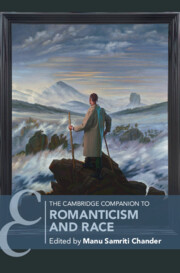Book contents
- The Cambridge Companion to Romanticism and Race
- The Cambridge Companion to Romanticism and Race
- Copyright page
- Contents
- Figures
- Contributors
- Acknowledgments
- Introduction
- Chapter 1 Burke and Kant on Color and Inheritance
- Chapter 2 Breathing Freedom in the Era of the Haitian Revolution
- Chapter 3 Afropessimism, Queer Negativity, and the Limits of Romanticism
- Chapter 4 Samuel Taylor Coleridge’s Racial Imaginary
- Chapter 5 (Not)freedom
- Chapter 6 Disability and Race
- Chapter 7 The Crip Foundations of Romantic Medicine
- Chapter 8 The Voice of Complaint
- Chapter 9 Romantic Manscapes
- Chapter 10 Romantic Poetry and Constructions of Indigeneity
- Chapter 11 Romanticism and the Novel(ty) of Race
- Chapter 12 Reading Race Along the “Bounding Line”
- Chapter 13 The Racecraft of Romantic Stagecraft
- Further Reading
- Index
- Cambridge Companions To Literature
Chapter 1 - Burke and Kant on Color and Inheritance
Published online by Cambridge University Press: 21 November 2024
- The Cambridge Companion to Romanticism and Race
- The Cambridge Companion to Romanticism and Race
- Copyright page
- Contents
- Figures
- Contributors
- Acknowledgments
- Introduction
- Chapter 1 Burke and Kant on Color and Inheritance
- Chapter 2 Breathing Freedom in the Era of the Haitian Revolution
- Chapter 3 Afropessimism, Queer Negativity, and the Limits of Romanticism
- Chapter 4 Samuel Taylor Coleridge’s Racial Imaginary
- Chapter 5 (Not)freedom
- Chapter 6 Disability and Race
- Chapter 7 The Crip Foundations of Romantic Medicine
- Chapter 8 The Voice of Complaint
- Chapter 9 Romantic Manscapes
- Chapter 10 Romantic Poetry and Constructions of Indigeneity
- Chapter 11 Romanticism and the Novel(ty) of Race
- Chapter 12 Reading Race Along the “Bounding Line”
- Chapter 13 The Racecraft of Romantic Stagecraft
- Further Reading
- Index
- Cambridge Companions To Literature
Summary
Yoon Sun Lee discusses how Enlightenment understandings of race shaped ideas about inheritance, such that property ownership came to be understood in racialized terms and race came to be understood in economic terms. Burke’s and Kant’s writings about heritability thus shed light on the doctrine of partus sequitur ventrem, whereby, as Lee puts it, “enslaved women of African descent bore children who counted not as population that could inherit things but as property that could be inherited by others, on the basis of a color that had to be ascribed or assumed as the material sign of a legal condition.”
- Type
- Chapter
- Information
- The Cambridge Companion to Romanticism and Race , pp. 7 - 21Publisher: Cambridge University PressPrint publication year: 2024

